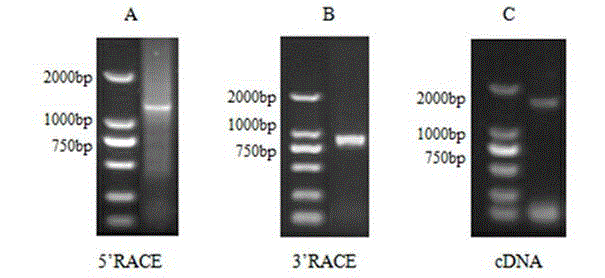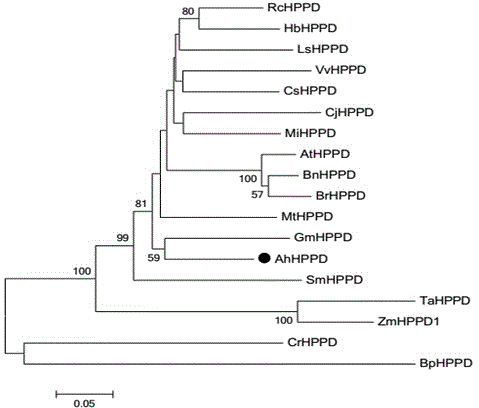Peanut vitamin E synthesis key gene and application thereof
A key gene and vitamin technology, which is applied in the key gene and application field of peanut vitamin E synthesis, can solve the problems of nutrient destruction, peculiar smell, easy rancidity, etc., and achieve the effect of extending shelf life, increasing content and activity
- Summary
- Abstract
- Description
- Claims
- Application Information
AI Technical Summary
Problems solved by technology
Method used
Image
Examples
Embodiment 1
[0021] [Example 1] Cloning by electronic cloning technology AhCYP707A gene open reading frame
[0022]According to the candidate gene fragments obtained from the transcriptome data of peanut 454 sequencing, primers AhHPPD-F (5'-TCCACGAGTTCGCTGAGTTC-3') and AhHPPD-R (5'-CAAGTGCTGCAACCCTGCACCTTCGTTG -3') were designed to verify the mixing of Minhua 6 tissues Whether there is the gene fragment in the full-length cDNA library, and then combined with LibF-45 (5'-GATTCTGTGGATAACCGTATTACCGCCTTACGCGTGTAAAACGAC-3') and LibR-39 (5'-ACCAGGATCTCCTAGGGAAACAGCTATGACCATGTTCAC-3') primers designed according to the library vector, RACE reaction is carried out. RACE reaction conditions: 5′ RACE reaction with AhHPPD-R and LibF-45 as primers, PCR amplification conditions: 94°C for 5min; 94°C for 30s, 70°C for 2min, 10 cycles; 94°C for 30s, 66°C for 30s, 72°C 2min at ℃, 25 cycles; 10min at 72℃. Use AhHPPD-F and LibR-39 as primers for 3′ RACE reaction, PCR amplification conditions: 94°C 5min; 94...
Embodiment 2
[0025] [Example 2] Extraction of Total RNA from Peanut Embryos in Different Tissues and Different Development Stages
[0026] Taking Minhua No.6, an excellent peanut variety bred by Fujian Agriculture and Forestry University, as the material, 8 tissues of roots, stems, leaves, flowers, fruit needles, pericarp, seed coats, and embryos of different developmental stages were collected, as well as the different developmental stages. Embryos are fresh embryos taken 20 days, 40 days, and 60 days after the fruit needles were buried in the soil, and stored at -80°C for later use. Preheat 1.7mL CTAB extract (65°C) and 80μl mercaptoethanol to 65°C; add the ground material, vortex for 2min, incubate at 65°C for 15-30min, invert and mix 3-4 times, add 1 / 10 Volume of absolute ethanol, 1 / 10 volume of 3MKAc, equal volume of phenol / chloroform / isoamyl alcohol (25:24:1), invert and mix at room temperature for 10 min. Centrifuge at 12000r / min for 15min at 4°C; take the supernatant, add an eq...
Embodiment 3
[0027] [Example 3] qRT-PCR analysis AhHPPD expression pattern
[0028] Total RNA was extracted from different peanut tissues and embryos at different developmental stages by the above-mentioned modified CTAB method, and 1 μg was reverse-transcribed with PrimeScript® Reverse Transcriptase reverse transcriptase (purchased from TAKARA Company). After diluting the single-stranded cDNA 10 times, take 2 μL as a template, and operate according to the SYBR? Premix Ex Taq? Kit protocol of TAKARA Company, using Mastercylcer ep realplex (Eppendorf) with specific primers AhHPPD_RT_F (5'-AGAAGAACTGCATAATGGGATTCGGTC-3'); AhHPPD_RT_R ( 5'-GAAAGGAGCATTGCCCAAGTGACTGTG-3'); Ahactin F (5'-GAGGAGAAGCAGAAGCAAGTTG-3'), Ahactin R (5'-AGACAGCATATCGGCACTCATC-3') for qRT-PCR. The expression of the gene in the sample was analyzed according to the ΔΔCT method. Analysis by qRT-PCR AhHPPD See Figure 4 for the relative expression levels of mRNA in each peanut tissue and three stages of embryo developme...
PUM
 Login to View More
Login to View More Abstract
Description
Claims
Application Information
 Login to View More
Login to View More - R&D
- Intellectual Property
- Life Sciences
- Materials
- Tech Scout
- Unparalleled Data Quality
- Higher Quality Content
- 60% Fewer Hallucinations
Browse by: Latest US Patents, China's latest patents, Technical Efficacy Thesaurus, Application Domain, Technology Topic, Popular Technical Reports.
© 2025 PatSnap. All rights reserved.Legal|Privacy policy|Modern Slavery Act Transparency Statement|Sitemap|About US| Contact US: help@patsnap.com



